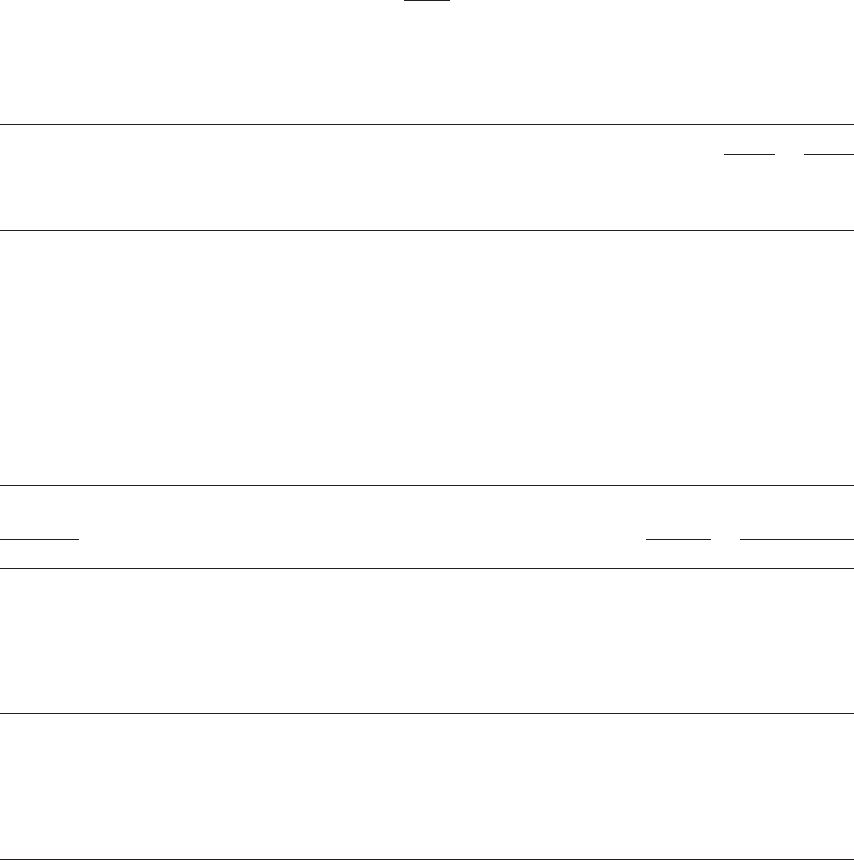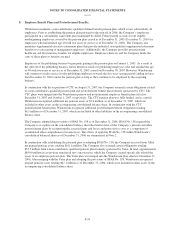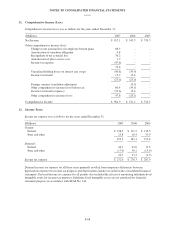Windstream 2007 Annual Report Download - page 149
Download and view the complete annual report
Please find page 149 of the 2007 Windstream annual report below. You can navigate through the pages in the report by either clicking on the pages listed below, or by using the keyword search tool below to find specific information within the annual report.
NOTES TO CONSOLIDATED FINANCIAL STATEMENTS
8. Employee Benefit Plans and Postretirement Benefits, Continued:
Information regarding the healthcare cost trend rate was as follows for the years ended December 31:
2007 2006
Healthcare cost trend rate assumed for next year 9.00% 9.00%
Rate that the cost trend rate ultimately declines to 5.00% 5.00%
Year that the rate reaches the terminal rate 2014 2013
For the year ended December 31, 2007, a one percent increase in the assumed healthcare cost trend rate would
increase the postretirement benefit cost by approximately $1.3 million, while a one percent decrease in the rate
would reduce the postretirement benefit cost by approximately $1.1 million. As of December 31, 2007, a one
percent increase in the assumed healthcare cost trend rate would increase the postretirement benefit obligation by
approximately $18.3 million, while a one percent decrease in the rate would reduce the postretirement benefit
obligation by approximately $15.7 million.
Estimated future employer contributions, benefit payments and Medicare prescription drug subsidies expected to
offset future postretirement benefit payments are as follows as of December 31, 2007:
(Millions)
Pension
Benefits
Postretirement
Benefits
Expected employer contributions for 2008 $ 0.7 $ 16.6
Expected benefit payments:
2008 $ 55.6 $ 17.4
2009 57.3 18.3
2010 59.0 19.0
2011 61.0 19.7
2012 – 2017 418.0 115.0
Expected Medicare prescription drug subsidies:
2008 $ 0.8
2009 0.9
2010 1.0
2011 1.1
2012 – 2017 9.1
The expected employer contribution for pension benefits consists of $0.7 million necessary to fund the expected
benefit payments related to the unfunded supplemental retirement pension plans. Future discretionary
contributions to the plan will depend on various factors, including future investment performance, changes in
future discount rates and changes in the demographics of the population participating in the Company’s pension
plan. Expected benefit payments include amounts to be paid from the plans or directly from the Company’s assets,
and exclude amounts that will be funded by participant contributions to the plans.
Under the Medicare Prescription Drug, Improvement and Modernization Act of 2003, (the “Act”) beginning in
2006, a prescription drug benefit is provided under Medicare Part D, as well as a federal subsidy to plan sponsors
of retiree healthcare plans that provide a prescription drug benefit to their participants that is at least actuarially
equivalent to the benefit that will be available under Medicare. The amount of the federal subsidy is based on
28 percent of an individual beneficiary’s annual eligible prescription drug costs ranging between $250 and $5,000.
The Company determined that a substantial portion of the prescription drug benefits provided under its
postretirement benefit plan are deemed actuarially equivalent to the benefits provided under Medicare Part D.
The Company sponsors an employee savings plan under section 401(k) of the Internal Revenue Code, which
covers substantially all salaried employees and certain bargaining unit employees. Employees may elect to
contribute to the plans a portion of their eligible pretax compensation up to certain limits as specified by the plans
and by the Internal Revenue Service. Prior to January 1, 2006, the Company made annual contributions to the
plan. Effective January 1, 2006, the plan was amended to provide for an employer matching contribution of up to
F-63
























